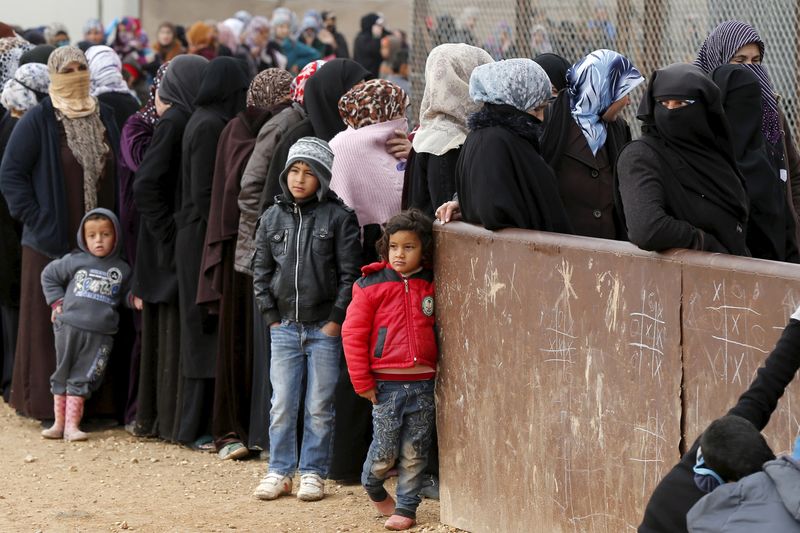By Suleiman Al-Khalidi
HADALAT, Jordan (Reuters) - Syrian refugees who have trekked across the desert fleeing expanding Russian air strikes are receiving a less-than-warm welcome in Jordan, which is keeping them penned up miles from anywhere on the grounds some of them may be militants.
Some 17,000 Syrians are now stranded in a de facto no-man's land at the only crossing where Jordan still receives refugees, in sparsely populated desert where the borders of Syria, Jordan and Iraq meet some 330 km (200 miles) northeast of Amman.
Abu Talaat Nejm, among a handful of refugees allowed in last week, said he fled with his wife and four children from Islamic State-held Qaryatain, a town in the desert east of Homs that the Syrian government and its allies are trying to recapture.
"I fled for safety with my children from the raids," he told Reuters during a media visit to the area organised by the Jordanian army. "I don't understand why they have to shell markets and homes and kill innocent people."
Human Rights Watch (HRW) published satellite imagery of the areas last June showing hundreds of people already crowded at the border. It said those let in were then forcibly deported back to Syria.
But the situation has become much worse since Russia started air strikes on Sept. 30 in its effort to support President Bashar al-Assad, at first concentrated on the north and since December expanded towards Islamic State-held areas in central and eastern Syria.
"When Russia entered the crisis there was a much bigger inflow of refugees and wounded," Brigadier General Saber al-Mahayreh, commander of Jordan's Border Guard, told reporters on the visit.
Part of the U.S.-led coalition that is bombing Syria, Jordan has long been praised for helping refugees and been a big beneficiary of foreign aid as a result.
But it is now drawing criticism from Western allies as well as the U.N. High Commissioner for Refugees and other aid agencies for over the situation at Hadalat.
The UNHCR in December said Jordan should accept the refugees and move them on to established camps closer to the capital, Amman. U.S. President Barack Obama raised the issue with King Abdullah last year.
But Jordan, which has already accepted more than 600,000 U.N. registered Syrian refugees, is resisting and says it believes that Islamic State militants may have infiltrated their ranks.
"Security for me is the most important thing," Jordanian government spokesman Mohammad al-Momani told reporters.
THROWN INTO THE DESERT
The crossing at Hadalat, a military zone far from any inhabited area in either Syria or Jordan, is a three-kilometre (two-mile) stretch of berms built a decade ago to combat smuggling. The rest of the border is heavily guarded by patrols and drones.
The refugees, most of them families, women and children, walked for days and now inhabit the area between two berms - technically part of Jordan - devoid of water, vegetation or shade, housed in tents woven from blankets and cloth.
Relief workers who declined to be identified due to the sensitivities of the situation said there have been reports of fatalities due to the conditions, without giving details.
When reporters visited the area, a border guard was beseeching an elderly Syrian woman to be patient as she jostled with others trying to get through the barrier that would bring her into Jordan proper.
"We are widows, we have no-one," she called to the guard. "We are thrown in the middle of the desert! Have mercy for God's sake."
Earlier waves of Syrian refugees had a much easier time, some walking just a few hundred metres to cross into Jordan from the main population centres.
Seeking to stem the flow, Jordan sealed those border crossings in 2013.
Donors suspect Jordan is just trying keep refugees away from its cities and under the observation of its security forces, and are hesitant to provide aid to any place that would be construed as legitimising its presence as a camp.
They say the cost of trucking water and food is prohibitive in such a remote area, and many times higher than providing aid for refugees closer to Amman.
They also insist the only solution is to allow refugees entry and travel to Azraq, a camp 100 km (60 miles) east of the capital Amman which was opened with tens of millions of dollars of aid but which remains virtually empty, and the current Zaatari camp, which houses around 80,000 people.
With aid groups and Jordan at loggerheads, most of the relief at Hadalat is being delivered by the International Committee of the Red Cross (ICRC).
The situation will be discussed at a Syrian donor conference scheduled for February in London, diplomats and officials say.
"The challenge is ... to address the security concerns of the government so that people can be brought in," said Andrew Harper, head of the UNHCR's Jordan mission. "But we will not set up a camp in an insecure environment."
UNHCR chief Filippo Grandi met King Abdullah on Monday and told a news conference afterward refugees should be admitted as soon as possible.

"What we're saying to the Jordanian government ... is that once those security concerns are satisfied, once people are screened properly and it is ascertained that there is no dangerous elements among them, then they should be progressively, but as rapidly as possible, admitted," he said.